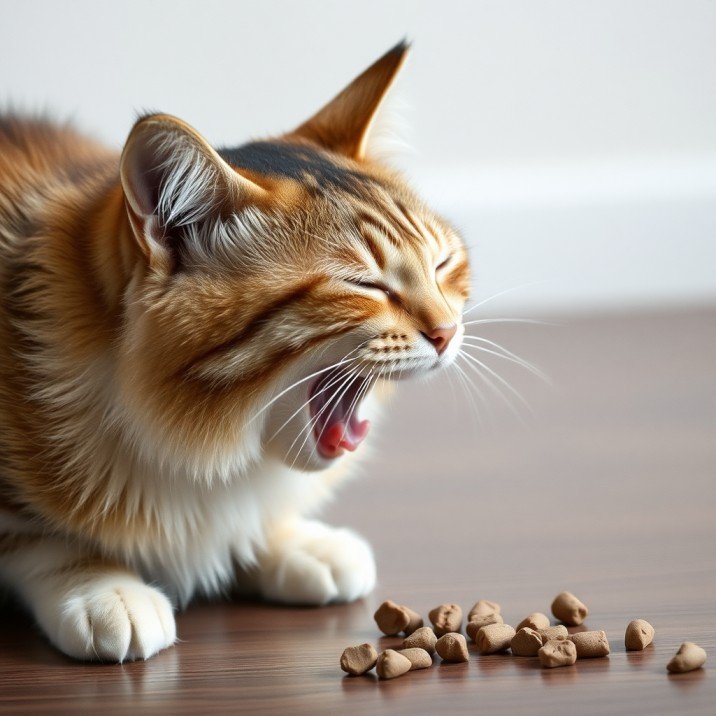Cat Vomiting: Causes, Prevention, and When to See a Vet
Cat Vomiting: Causes, Prevention, and When to See a Vet
Cats vomit from time to time—it’s one of the more common concerns cat owners face. While an occasional hairball may be harmless, frequent or severe vomiting can signal an underlying issue. Understanding the causes of cat vomiting and knowing when to act can help keep your feline friend healthy and safe.
Why Do Cats Vomit?
Vomiting is a reflex that helps cats expel irritants or indigestible materials from their stomachs. It’s important to distinguish between:
- Occasional vomiting (e.g., hairballs or eating too quickly), which may be normal
- Chronic or sudden vomiting, which may indicate illness and needs attention
Common Causes of Cat Vomiting
Here are the most common reasons behind cat vomiting:
1. Hairballs
Long-haired cats, like Persians and Maine Coons, often groom themselves by licking their fur. This leads to hair ingestion, which can clump into hairballs and trigger vomiting. Hairballs are usually cylindrical and coated with saliva.
2. Eating Too Fast
Some cats gulp down food quickly, which can lead to regurgitation or vomiting right after meals. This isn’t always serious but should be monitored.
3. Dietary Indiscretion
Cats that eat spoiled food, grass, or human food can suffer from stomach upset. Sudden changes in diet can also lead to vomiting.
4. Food Allergies or Intolerances
Some cats have sensitivities to certain ingredients in commercial pet food, such as grains, artificial additives, or specific proteins.
5. Parasites
Worms or intestinal parasites can irritate the stomach lining, leading to vomiting and other digestive issues.
6. Toxins and Poisoning
Ingesting poisonous plants, household cleaners, or human medications can trigger vomiting as a warning sign. Always keep such items out of reach.
7. Infections or Illness
Conditions like pancreatitis, liver disease, or viral infections (e.g., feline parvovirus) can cause vomiting. These require immediate veterinary care.
8. Obstructions
A swallowed toy, string, or bone can cause a blockage in your cat’s digestive tract. This is a medical emergency and often causes repeated vomiting, drooling, and abdominal pain.
Types of Vomit: What Do They Mean?
The color and contents of your cat’s vomit can provide helpful clues:
| Vomit Appearance | Possible Meaning |
|---|---|
| Yellow or bile | Empty stomach or acid buildup |
| White foam | Hunger or stress-related |
| Undigested food | Eating too quickly |
| Hairball | Normal grooming response |
| Blood (red or brown) | Possible internal bleeding—emergency |
| Green or plant matter | Grass or plant ingestion |
Take note of how often your cat vomits and what the vomit contains. This information helps your vet diagnose the issue more effectively.
When to See a Veterinarian
Not all vomiting is a cause for panic—but there are red flags. Seek veterinary care if your cat:
- Vomits more than once a day
- Refuses to eat or drink
- Shows signs of lethargy or weakness
- Has diarrhea along with vomiting
- Has blood in the vomit
- Appears bloated or in pain
- Loses weight rapidly
If vomiting persists for more than 24 hours or is accompanied by other concerning symptoms, don’t wait—get professional help.
How Vets Diagnose Cat Vomiting
Your vet may perform:
- Physical examination
- Blood tests to check organ function
- X-rays or ultrasounds to detect obstructions or tumors
- Fecal tests to detect parasites
- Dietary trials if food intolerance is suspected
Depending on the cause, treatment might include fluids, medication, deworming, or changes in diet.
How to Prevent Vomiting in Cats
You can’t always prevent vomiting, but here are steps to reduce its frequency:
1. Feed Smaller, Frequent Meals
This helps cats who eat too fast or have sensitive stomachs. Slow feeder bowls can also help.
2. Regular Grooming
Brushing your cat daily—especially if they’re long-haired—minimizes loose fur and reduces hairballs.
3. Choose High-Quality Cat Food
Opt for food with real protein, no artificial additives, and ingredients that support digestive health. Avoid sudden diet changes.
4. Keep Dangerous Items Out of Reach
Secure cleaning products, medications, and plants like lilies that are toxic to cats.
5. Deworm Regularly
Follow your vet’s advice on parasite control, especially if your cat goes outside.
Home Remedies: Use with Caution
Some home remedies can help with mild cases:
- Pumpkin puree (unsweetened): Helps with digestion
- Hairball control gels: Lubricates digestive tract
- Hydration: Ensure your cat has access to clean, fresh water at all times
Important: Never give your cat over-the-counter human medications without vet approval.
Conclusion
An occasional episode of cat vomiting may be harmless, but frequent or severe cases deserve attention. By understanding the causes and watching for warning signs, you can take better care of your feline friend. From proper grooming to quality food and regular vet visits, prevention is always the best medicine.








Leave feedback about this